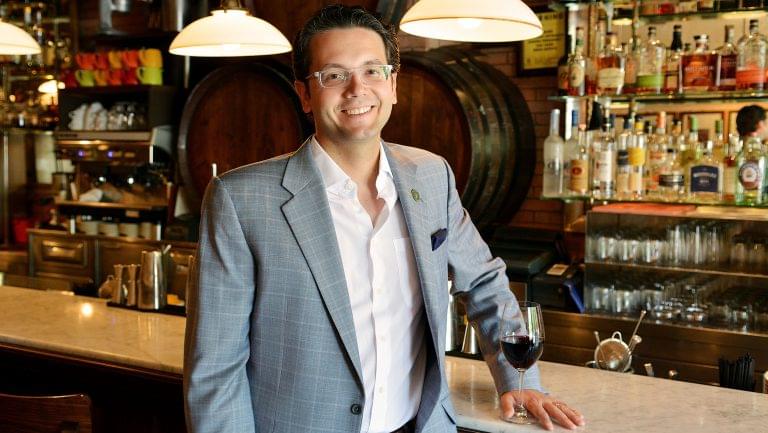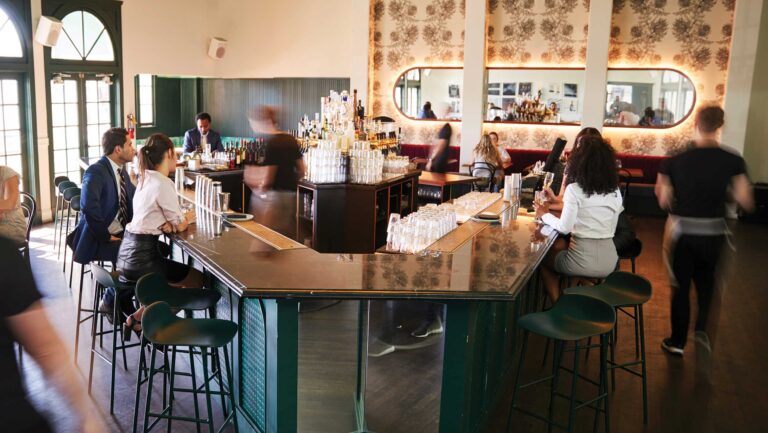Hristo Zisovski, the beverage director at the Altamarea Restaurant Group, has a reputation for running a tight ship staffed by a dedicated, enthusiastic crew. One of the secrets of his success is maintaining a team of versatile employees who are equipped to ensure that wine and cocktail lists are well crafted, service is top-notch, and all aspects of their business runs smoothly.
Zisovski’s staff-training philosophy can be summed up by one of his mottos: You’ve got to learn the trade before you learn the tricks of the trade. At Altamarea, staff members learn the craft literally from the very bottom: in the wine cellar, where they’re introduced to the inventory. By focusing on the basics, Zisovski’s staff is able to enjoy the benefits of a well-oiled machine. That focus also ensures there will be time for the important stuff, which, says Zisovski, is also the fun stuff—the staff wine tastings.
Alessandro Piliego, wine director at Altamarea’s Ristorante Morini, in New York City, joined Altamarea as a sommelier three years ago at Costata and has been at Ristorante Morini since last January. He says Altamarea is like an “Eden” for sommeliers. “I was taken care of from day one,” he says. “It’s hard to find such thorough and detailed training in a beverage program that’s quite so large.”

Don’t miss the latest drinks industry news and insights. Sign up for our award-winning newsletters and get insider intel, resources, and trends delivered to your inbox every week.
SevenFifty Daily reached out to Zisovski to learn more about his training style and to get his advice on how to cultivate a stellar team of somms.
1. Spot talent and cultivate it.
People who need to be babysat, says Zisovski, are not the type of people who do well in the beverage industry. He looks for self-motivated people who are empathetic, patient, and willing to go with the system he has established. “It’s not easy to find good staff, but if you find people who want to learn, and you do some advertising, you’ll get a lot out of it,” he says. Zisovski makes sure members of his staff get the opportunity to work on different projects so that they can see where their skills and interests are a good fit. Eventually, an employee may get a chance to work in every part of the operation. “And slowly,” says Zisovski, “that’s how a wine director gets promoted.”
2. Get the basics down.
Zisovski’s new employees spend the first two months focusing on the very basics. The time spent in basic training may feel like drudgery, but the work pays off for everyone when each somm knows how everything works from bottom to top. Newcomers start by getting acquainted with the inventory. Zisovski says that learning about the seemingly mundane aspects of the business, such as how to use Altamarea’s inventory management software, BinWise, also gives staff a greater sense of ownership over the final product—he trains his staff to know why they are doing what they do, not just how to do it. “These are the little tiny building blocks,” he says, “that allow you to make the building as high as you want afterward.”
3. Give your staff autonomy.
Once staff members are trained, Zisovski trusts them to do their job with minimal interference. He says that after a new position is filled, he will normally do much of the inventory work himself to make sure nothing gets lost. Once a new hire masters how to process sales, Zisovski will teach that person how to add inventory, and then how to create a wine list. “I go from doing it all, to then micromanaging, to then macromanaging, to then being available when they need something,” he says. Once a wine director is comfortable in the position, Zisovski says he checks in occasionally but wants the wine director to feel independent. “His way of training is not [about] imposing,” says Piliego. “It is [about] exploring what will work.”
4. Know how to craft a drinks list.
The key to crafting a drinks list is to know your audience, says Zisovski. “Marea and Ai Fiori are luxury restaurants,” he says, “so you need those $200-to-$300 bottles of Burgundy and Barolo.” For another restaurant, the sweet spot might be $50—and it’s important to know the difference. The truly great wine directors will know exactly why they have every item in their inventory, and who will buy it. Piliego says that Zisovski tells wine directors that he is okay with whatever wine they want to buy—as long as they can sell it. “His motto,” says Piliego, “is if you can sell it, you can put it on the list.” Unlike more corporate restaurants that may limit changes to the wine list, says Piliego, Altamarea is flexible with updates and encourages experimentation.
5. Build a wine culture.
The most important part of the job for Zisovski is the community surrounding it. Beverage services are an art, he says, and the many tasks involved in making sure his operation is a success are important because they allow time for the main event. “It’s all the check marks you need to do to then be able to meet with winemakers or do a wine trip,” he says. Because so much of Altamarea’s inventory is based in Europe, it’s rare for Zisovski’s staff to go on wine trips to the places they most commonly source wine from, but he says that he does try to make time for frequent wine tastings. “In a way,” he says, “it’s all about community.”

Dispatch
Sign up for our award-winning newsletter
Don’t miss the latest drinks industry news and insights—delivered to your inbox every week.
Tucker Higgins is a reporter based in Brooklyn. He received a degree in international relations from the College of William in Mary, and graduated from the Dow Jones News Fund’s business reporting program. View more of his work at https://tuckerhiggins.press.







